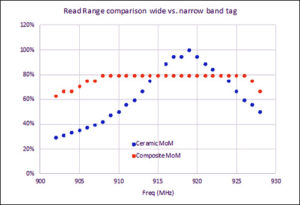Users often evaluate RFID tag performance based on one factor: read range. This isn’t necessarily a bad thing—in many situations, it makes sense to use read range as shorthand for performance. But another factor can have a big of an impact in real-world applications, and ignoring it can cost you: response bandwidth.
 What Is RFID Response Bandwidth?
What Is RFID Response Bandwidth?
Response bandwidth has to do with the interactions between RFID tags and readers. RFID readers in North America operate in a frequency band between 902 and 928 MHz. The readers frequency-hop within this band, changing frequencies at random. This helps them avoid interference with other readers within their vicinity.
Response bandwidth, then, is the ability of an RFID tag to respond to signals at a variety of frequencies within the band. The figure below illustrates this idea. The wider the bandwidth (f2-f1), the more frequencies to which the tag can respond. Put another way, RFID tags that have a wide response bandwidth are more likely to be able to respond to any given query sent by a reader. This relationship affects how RFID applications perform in the real world.

How Bandwidth Impacts Performance
Most commercial RFID tags are label-style tags designed to be mounted on surfaces like cardboard or fabric. These tags have very broad frequency response and provide a similar response regardless of the frequency of the query signal. This is one reason RFID is so popular for tracking commercial inventory through supply chains. But things change when tags are designed to be applied to metal.
Passive RFID tags are designed to gather energy and respond to query signals from a reader. Metal surfaces, however, interfere with these signals. As a result, mount-on-metal (MoM) tags must gather energy from the reflected signal above the surface of the metal. To do this, MoM tags are designed with a resonant cavity antenna embedded on the surface and in the body of the tag.
But resonant cavity designs come with a trade-off. As the cavity becomes smaller, response bandwidth shrinks. Many MoM tags are designed to be mounted to objects with limited space for mounting, so they are small. These small tags tend to have a very narrow bandwidth. Another issue is that MoM tags are often used in close proximity to one another. The objects to which they’re attached scatter radio waves and can shadow read areas. As a result, one tag may be readable on one frequency but not on another.
Read Range vs. Bandwidth in the Real World
How does this relate to real-world system performance? Consider the graph below. It shows two commercially available MoM tags: a 13-millimeter by 7-millimeter (0.5-inch by 0.3-inch) ceramic tag and a smaller 10-millimeter by 5-millimeter (0.4-inch by 0.2-inch) composite tag. The ceramic tag shows a better read range for a few frequencies, but it falls off for more than half the band. At most frequencies, the ceramic tag actually has a shorter read range than the composite tag.
In a real-world setting, a collection of the composite tags is likely to perform better than the longer-read-range ceramic tags. This is because they’re designed to compensate for frequency hopping and shadowing effects. A tag’s response frequency affects the way it performs in real-world applications. The bottom line: don’t select a tag solely on the basis of read range. If you do, you may have missed reads and poor system performance, especially in high-density environments containing many tags.
Ken Horton is a co-founder of Vizinex and the firm’s CEO, CFO and VP of sales and marketing. Ken has worked in the RFID field since 2008 in operations, engineering, sales and marketing roles. Prior to the founding of Vizinex, he served in leadership positions at several technology firms. Throughout the past 25 years, his industry experience has included medical instruments, automated electronic assembly equipment and semiconductor production equipment. Ken received a bachelor’s degree in engineering sciences from Dartmouth College and an MBA from Stanford University. He is a graduate of General Electric’s two-year Manufacturing Management Program.


